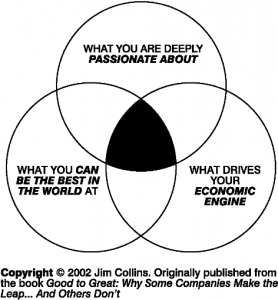If you can find the intersection of your passion, expertise and market demand, you will have a winning concept.
Chapter 5: The Hedgehog Concept
The bottom line here is to find your company’s sweet spot. If you can find the intersection of your passion, expertise and market demand, you will have a winning concept. Execution is then the key to success. You don’t have to do everything well. If you do one thing better than others, you will succeed (ex. Hedgehog protects itself very well from a fox)
Chapter 6: A Culture of Discipline
I have always believed that to have sustained growth, you need systems and processes. When a company is small, a key person can hold things together, allowing the company to grow. But at some point, that breaks down. It could be that the person is no longer in the position, or the volume is too large to handle. Systems and processes are inevitably needed when the company exceeds a certain number of employees, or when volume exceeds the capacity of a few. Systems should not be put in place too early, or the business can stall.
Discipline is critical to consistent growth, quality and customer experience. When the company understands its sweet spot (hedgehog), then it is only a lack of execution that will bring failure.
Chapter 7: Technology Accelerators
My Bachelor’s degree is in Electrical and Computer Engineering. I love technology – inventing it, using it, evangelizing it, and watching how it changes the world. But, just using technology does not make companies great. Technology can be an enabler or can make things more efficient. Without a sound strategy and process, technology can just get in the way. Once you have the process in place, then consider automating it. Do it manually first (brute force) to prove that it will work, and then use technology.
Chapter 8: The Flywheel and the Doom Loop
Few people today know what a flywheel is, but it is an incredible mechanical invention. The basic concept is that a flywheel is heavy and it takes a lot of effort to get it going, but it also takes a lot to slow it down. Once it is going, small incremental efforts can prevent it from slowing.
This applies in business. It takes time to build momentum, and once built up, it will take something drastic for the momentum to come to an abrupt halt. Yet, if a business tries to go fast too quickly, it can also be stopped quickly. A company is in the doom loop if it tries to find quick fixes and tries many different directions without doing the work to build something sustainable.
Once you have your hedgehog, get great people, and start pushing on the flywheel.
Good to Great is not just for big companies. Small companies have to go through the same steps to build a great company, no matter if the goal is to keep it small but profitable or grow it to something that can be sold one day.

 (
(